
Vietnamese cuisine encompasses the foods and beverages of Vietnam. Meals feature a combination of five fundamental tastes : sweet, salty, bitter, sour, and spicy. The distinctive nature of each dish reflects one or more elements, which are also based around a five-pronged philosophy. Vietnamese recipes use ingredients like lemongrass, ginger, mint, Vietnamese mint, long coriander, Saigon cinnamon, bird's eye chili, lime, and Thai basil leaves. Traditional Vietnamese cooking has often been characterised as using fresh ingredients, not using much dairy or oil, having interesting textures, and making use of herbs and vegetables. The cuisine is also low in sugar and is almost always naturally gluten-free, as many of the dishes are rice-based instead of wheat-based, made with rice noodles, papers and flour. Vietnamese cuisine is strongly influenced not only by the cuisines of neighboring China, Cambodia and Laos, but also by French cuisine due to French colonial rule over the region from 1887 to 1954.

Mountain Dew, stylized as Mtn Dew in some countries, is a carbonated soft drink brand produced and owned by PepsiCo. The original formula was invented in 1940 by Tennessee beverage bottlers Barney and Ally Hartman. A revised formula was created by Bill Bridgforth in 1958. The rights to this formula were obtained by the Tip Corporation of Marion, Virginia. William H. "Bill" Jones of the Tip Corporation further refined the formula, launching that version of Mountain Dew in 1961. In August 1964, the Mountain Dew brand and production rights were acquired from Tip by the Pepsi-Cola company, and the distribution expanded across the United States and Canada.
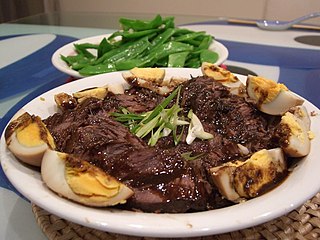
Braising is a combination-cooking method that uses both wet and dry heats: typically, the food is first browned at a high temperature, then simmered in a covered pot in cooking liquid. It is similar to stewing, but braising is done with less liquid and usually used for larger cuts of meat. Braising of meat is often referred to as pot roasting, though some authors make a distinction between the two methods, based on whether additional liquid is added. Osso buco and coq au vin are well known braised meat dishes, and the technique can also be used to prepare fish, tempeh, tofu or fruits and vegetables.
7 Up or Seven Up is an American brand of lemon-lime-flavored non-caffeinated soft drink. The brand and formula are owned by Keurig Dr Pepper although the beverage is internationally distributed by PepsiCo.

Puerto Rican cuisine has its roots in the cooking traditions and practices of Europe, Africa and the native Taínos.
Double-Cola is the name of a carbonated soft drink. It is manufactured by The Double Cola Company, headquartered in Chattanooga, Tennessee.

Coquito meaning "Little Coconut" in Spanish is a traditional Christmas drink that originated in Puerto Rico. The coconut-based alcoholic beverage is similar to eggnog, and is sometimes referred to as Puerto Rican Eggnog. The mixed drink is made with Puerto Rican rum, coconut milk, cream of coconut, sweetened condensed milk, vanilla, nutmeg, clove, and cinnamon.
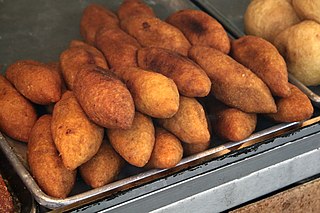
Alcapurria is a popular fritter dish from Puerto Rico.
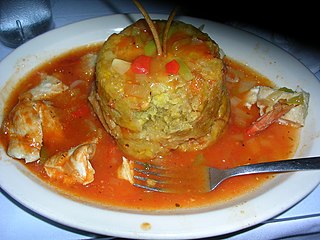
Mofongo is a Puerto Rican dish with plantains as its main ingredient. Plantains are picked green, cut into pieces and typically fried but can be boiled or roasted, then mashed with salt, garlic, broth, and olive oil in a wooden pilón. The goal is to produce a tight ball of mashed plantains that will absorb the attending condiments and have either pork cracklings (chicharrón) or bits of bacon inside. It is traditionally served with fried meat and chicken broth soup. Particular flavors result from variations that include vegetables, chicken, shrimp, beef, or octopus packed inside or around the plantain orb.

Gỏi cuốn or nem cuốn, salad roll, summer roll, fresh spring roll, spring roll, rice paper roll, is a Vietnamese dish traditionally consisting of pork, prawn, vegetables, bún, and other ingredients wrapped in Vietnamese bánh tráng. Unlike other spring roll dishes which are believed to be originated from China, Vietnamese gỏi cuốn is the country's creation using rice paper.

Thai basil called káu-chàn-thah in Taiwan, is a type of basil native to Southeast Asia that has been cultivated to provide distinctive traits. Widely used throughout Southeast Asia, its flavor, described as anise- and licorice-like and slightly spicy, is more stable under high or extended cooking temperatures than that of sweet basil. Thai basil has small, narrow leaves, purple stems, and pink-purple flowers.

Don Q is a Puerto Rican rum, distilled, manufactured, bottled, and distributed by Destilería Serrallés from its corporate facility in Ponce, Puerto Rico. Don Q, "Puerto Rico's best-known rum", is the top-selling rum in Puerto Rico, where over 70% of the rum consumed in the United States is produced. The rum derives its name from Don Quixote, the protagonist in Miguel de Cervantes' classic Spanish novel. The rum is sold internationally, competing against Bacardi for market share. Available in the continental United States since June 2009, Don Q continues to outsell Bacardi in Puerto Rico.

Ting is a carbonated beverage popular in the Caribbean. It is flavored with Jamaican grapefruit juice and is both tart and sweet. Ting comes in a green glass bottle, green plastic bottle or a green and yellow can. Like Orangina, the beverage contains a small amount of sediment consisting of grapefruit juice pulp. Ting is produced in the United Kingdom under license by Refresco Beverages. Ting also now makes Pink Ting Soda, Orange Ting, Diet Ting Soda, and ginger beer.
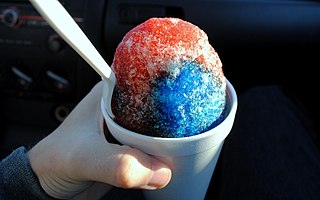
Shaved ice is a large family of ice-based desserts made of fine shavings of ice or finely crushed ice and sweet condiments or syrups. Usually, the syrup is added after the ice has been frozen and shaved—typically at the point of sale; however, flavoring can also be added before freezing. The dessert is consumed worldwide in various forms and ways. Shaved ice can also be mixed with large quantities of liquid to produce shaved ice drinks.

Dominican cuisine is made up of Spanish, indigenous Taíno, Middle Eastern and African influences.

Sorullos are a fried cornmeal-based dish that is a staple of the Puerto Rican cuisine. Sorullos are served as a side dish or as appetizers, and are sometimes stuffed with cheese. They can be served with mayoketchup, coffee or dusted in confectioners' sugar.
Champagne cola, Kola Champagne, or champagne soda is a sweetened carbonated beverage produced mainly in the tropics of Latin America, former British West Indies, and Pakistan. Kola Champagne was invented in Puerto Rico by Ángel Rivero Méndez. Rivero Méndez was a Captain in the Spanish Army during the Spanish–American War. In 1902, a few years after the end of the Spanish-American War, Rivero Méndez founded El Polo Norte Fábrica de Sodas where he created the Kola Champagne, which became, and still is, a popular soft drink in Puerto Rico. While elaborating the drink he worked on his book, Chronicle of the Spanish-American War in Puerto Rico.
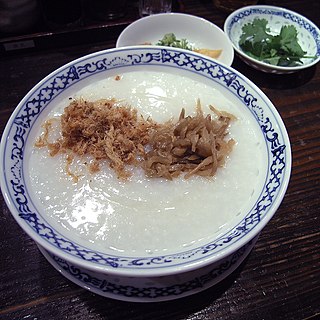
Congee or conjee is a type of rice porridge or gruel eaten in Asian countries. It can be eaten plain, where it is typically served with side dishes, or it can be served with ingredients such as meat, fish, seasonings and flavourings, most often savory, but sometimes sweet. It is typically served as a meal on its own, especially for breakfast or people who are ill. Names for congee are as varied as the style of its preparation, but all are made with rice cooked as a softened porridge with a larger quantity of water than other types of cooked rice like pilaf or claypot rice.

Burmese curry refers to a diverse array of dishes in Burmese cuisine that consist of protein or vegetables simmered or stewed in an aromatic curry base Burmese curries generally differ from other Southeast Asian curries in that Burmese curries make use of dried spices in addition to fresh herbs and aromatics, and are often milder. Burmese curries are readily available in curry houses throughout the country. They are traditionally accompanied with rice and a variety of side dishes, soups, and Burmese salads called athoke. Burmese curries may also be paired with Indian breads like nanbya, palata, aloo puri, and toshay.
















